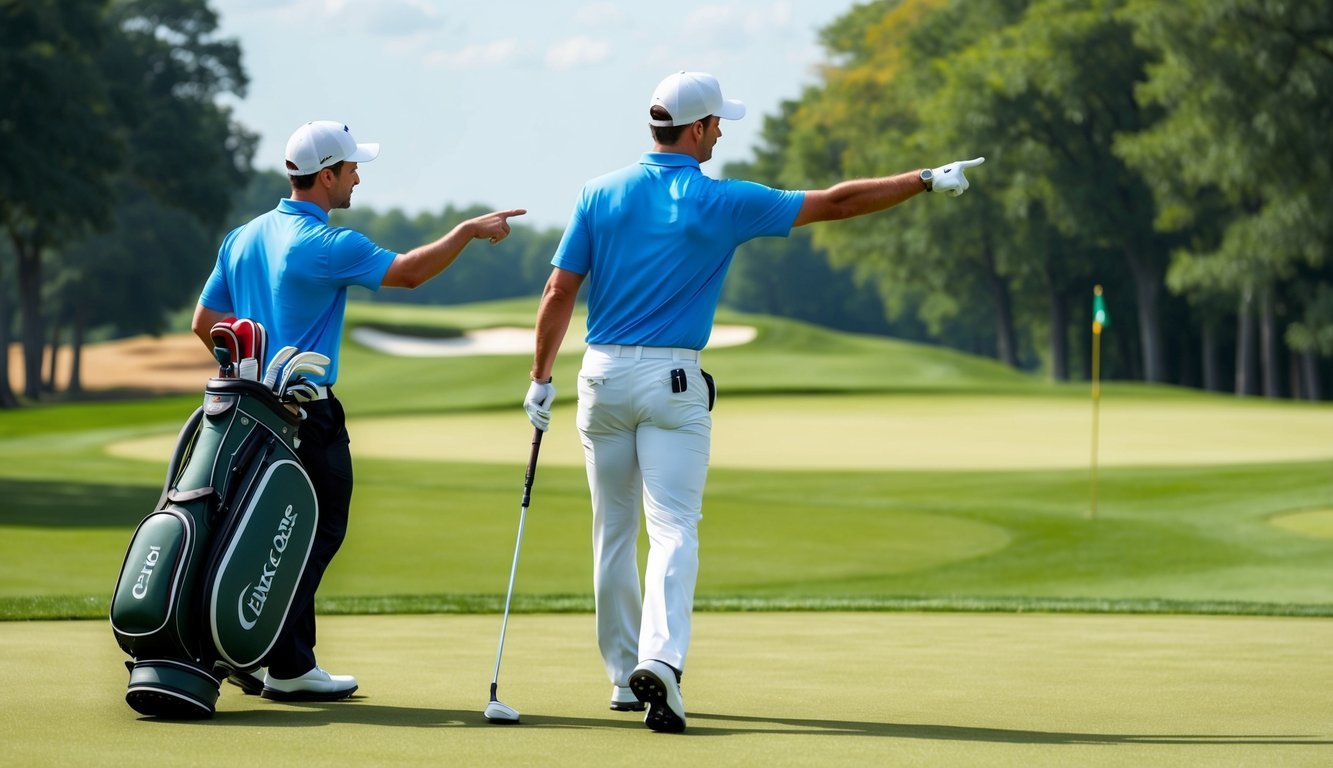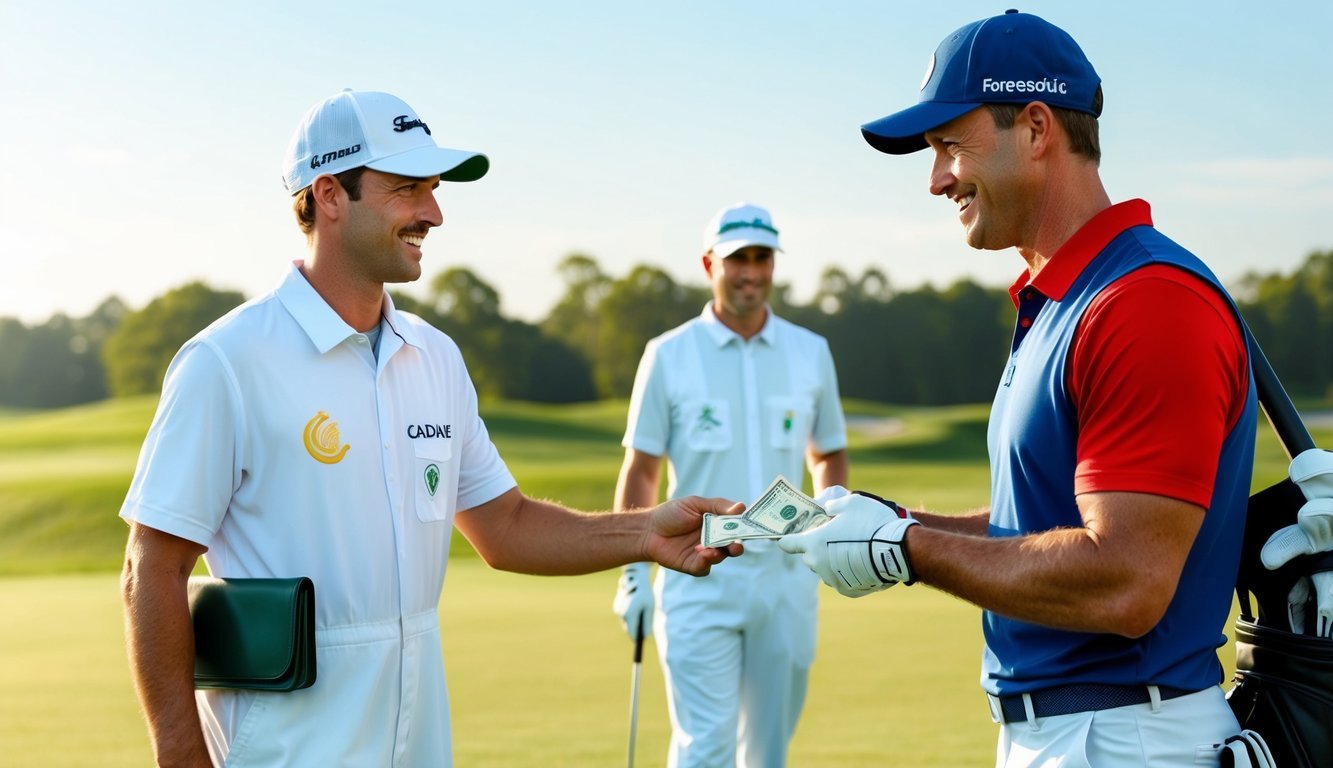Choosing between a forecaddie and a caddie can make a significant difference in optimizing your golf game. A caddie provides personalized assistance, carrying your clubs and offering valuable advice on shot selection.
Meanwhile, a forecaddie helps locate balls and manages the pace of play. This means that the role they play on the course differs, shaping how you experience the game.

Understanding these distinctions not only enhances your appreciation of golf’s rich traditions but also reveals how these roles contribute to the sport’s dynamics.
Whether playing in a casual round or a competitive setting, recognizing the responsibilities of each can guide you in making an informed decision.
Delving into what each brings to your game can help improve your overall experience.
If you’re navigating the nuances of hiring or tipping and wondering how these traditions play out in professional settings, exploring the role of caddies further can provide clarity.
You’ll gain insights into what might fit best into your own gameplay, enhancing both strategy and enjoyment on the course.
Key Takeaways
- Caddies offer personal guidance and carry clubs.
- Forecaddies locate balls and help manage pace.
- Choosing between them impacts your game approach.
Understanding the Roles
In the world of golf, caddies and forecaddies play crucial roles in enhancing your golfing experience.
They focus on different responsibilities, contributing to the smooth progression of the game.
Understanding these roles can significantly improve not only your performance but also your overall enjoyment of the sport.
Caddie Responsibilities
As a golfer, your caddie is your personal assistant and partner on the course.
Caddies are responsible for carrying your golf clubs, helping you select the right club for each shot.
Beyond simply carrying equipment, they offer strategic advice and insights into course conditions.
Caddies often provide feedback on factors like wind direction, slope, and shot distance.
With a keen vision for the game, they play a vital role in shaping your shot strategy.
Having a caddie on your side means benefiting from their expertise, ultimately helping to improve your overall performance on the course.
Their duties extend beyond physical tasks, focusing more on enriching your skillset and maximizing your potential during the game.
Forecaddie Duties
Unlike caddies, forecaddies are not assigned to a specific golfer but serve a group of players by focusing on the game flow.
Their primary job is to locate golf balls, ensuring they remain in play and directing golfers if a provisional shot is needed.
Forecaddies do not carry clubs, so their presence is more about strategic course management than personal assistance.
Positioned ahead of players, they provide real-time information about ball locations, helping speed up gameplay.
Although they do not give advice on game strategies, forecaddies significantly contribute to maintaining the pace and efficiency of the round.
They enhance the experience by minimizing lost balls and keeping the game moving smoothly.
The Player-Caddie Dynamic

Engaging a caddie in your golf experience adds a strategic dimension to your game.
Their insights and support can significantly influence your performance.
Communication and Strategy
In a round of golf, how you communicate with your caddie often defines the strategy you employ.
A good caddie acts almost like a coach, analyzing your current position, understanding course nuances, and advising on club selection.
You will find that discussing tactics and listening to their advice can sharpen your decision-making skills.
For example, by sharing your goals, the caddie can tailor advice to suit your style, whether it’s an aggressive play or a conservative approach.
This partnership is crucial, especially when the stakes are high.
In such scenarios, the caddie’s role intensifies as they help in recognizing hazards and navigating complex layouts.
Impact on Golfer Performance
The influence of a caddie extends beyond just carrying your clubs.
Their presence can often lead to improved mental focus and reduced stress during your round, thus enhancing your performance.
With their experience, they can offer you quick insights about the course, leading to more informed club choices and shot execution.
This guidance can significantly alter your game dynamics, particularly when you’re faced with challenging situations.
When a caddie helps you keep a cool head, it translates to better scores and more enjoyment on the course.
Working with a caddie gives you an edge, ensuring that every swing counts.
These interactions might even turn into valuable learning experiences, providing you with strategies to excel in future rounds.
On the Course

When you’re on the golf course, understanding the roles of both forecaddies and caddies can greatly enhance your experience.
These professionals not only support your play but also enrich your interaction with the course through their specialized skills and tools.
Tools and Equipment
Caddies and forecaddies are equipped with various tools to ensure your game runs smoothly.
Your caddie might carry an array of clubs and golf balls, offering personalized recommendations to suit different situations.
Forecaddies often utilize golf carts to move ahead, marking where balls land and pointing out hazards.
You may notice them using hand signals to communicate key information, especially on areas like fairways and greens.
Basic maintenance equipment is often part of their kit too, including items for raking bunkers and repairing divots.
Assisting with Course Navigation
On a large or complex golf course, forecaddies provide invaluable assistance in course navigation.
Picture them as your advanced scouts, moving ahead to monitor where balls land and spotting potential obstacles like bunkers and hazards.
They guide you through strategic decisions, such as selecting clubs for tricky shots.
Understanding hand signals, forecaddies efficiently inform you of pin placements and exact yardages needed.
This allows you to focus on your swing while confidently navigating the course, making the experience both enjoyable and rewarding.
Hiring and Tipping Practices

When hiring caddies and forecaddies, understanding the differences in their fees and the nuances of tipping etiquette is essential.
Both roles contribute significantly to your golf game, with unique duties and costs involved.
Forecaddie Fee and Caddie Pay
Hiring a forecaddie differs from hiring a personal caddie in terms of both role and cost.
A forecaddie works for the entire group, spotting golf balls and maintaining the pace of play.
Their fee typically depends on the golf course and may be shared among the group.
A personal caddie, on the other hand, focuses on assisting you directly with club selections, providing valuable insights, and carrying your golf bag.
Pay for caddies varies widely based on location, experience, and the prestige of the course.
Ensuring fair compensation reflects the quality of service received and respects industry standards.
Appropriate Tipping Etiquette
Tipping forms a crucial part of both caddie and forecaddie services.
It’s customary to tip caddies a percentage of their base fee.
Common practice suggests tipping a caddie about 20-50% of their fee.
For forecaddies, a smaller tip per player is usually adequate due to the shared nature of their role.
In tournaments or at prestigious courses, tips can be higher, reflecting appreciation for the professional service provided.
Asking your host for typical tipping practices at private clubs can help avoid any faux pas.
Generosity in tipping, especially for exceptional service, enhances the overall golfing experience and shows gratitude.
Caddies in Competitive Golf

Caddies play a crucial role in competitive golf, especially in professional tournaments.
They help maintain adherence to the rules and ensure a smooth game experience.
From managing course strategy to enforcing golf etiquette, their responsibilities are vast.
Involvement in Professional Tournaments
In professional tournaments, caddies are integral in assisting golfers with strategic decisions.
Their responsibilities include offering guidance on club selection and managing course conditions.
Caddies also play a significant part in reading greens, where their spatial awareness aids in assessing the best putting lines.
This knowledge helps players gauge distance and adjust their putting strokes accordingly.
Additionally, caddies often track the golf ball after each shot, ensuring it remains in play or advising on a provisional if needed.
Working closely with tournament organizers, they ensure compliance with the rules of golf, highlighting their pivotal role in the game.
Ensuring Adherence to Golf Etiquette
Caddies ensure that professional golfers adhere to the high standards expected in the sport.
They uphold golf etiquette by maintaining silence and managing the pace of play during critical shots.
They also play a vital role in course management by repairing divots and raking bunkers.
By doing so, they optimize conditions for subsequent players, aligning with etiquette norms.
Moreover, a caddie fosters a respectful atmosphere on the course.
Simple actions, like showing respect to other competitors or spectators, usually fall under their purview.
In essence, their involvement enhances the overall golf experience, both for their golfer and the audience.

